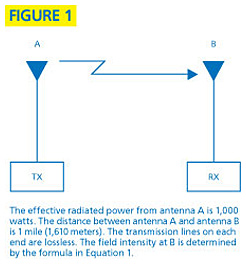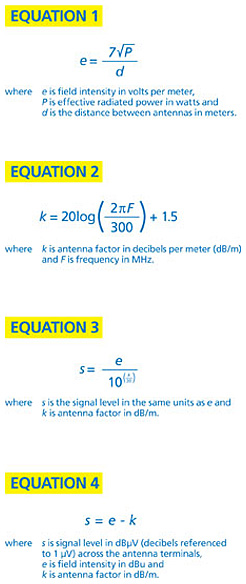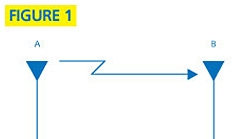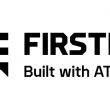Good to know
The term “field intensity” is used to indicate the intensity level of the signal at a given distance from the radiating antenna. A simplistic definition of field intensity might be: the level of the signal “in the air.” The basic unit of measure of field intensity is volts per meter, or V/m. In practice, millivolts per meter (mV/m) or microvolts per meter (µV/m) are used to indicate typical field intensity levels.
On the other hand, the signal level across the antenna terminals — or at the input/output of a receiver or stage of a system — usually is specified in terms of volts (V), millivolts (mV) or microvolts (µV), or decibels referenced to 1 milliwatt (dBm) or 1 watt (dBW). Actually, the terms dBm and dBW are used to represent power levels but easily can be converted to voltage as long as the system impedance is taken into account. For example, most RF technicians and engineers know from memory that 1 microvolt (1 µV) is equivalent to -107 dBm in a 50-ohm system. This article will help you to correlate the field intensity at the antenna to the signal level at the input to the receiver in practical situations.
Figure 1 shows a transmitter connected to a half-wave dipole antenna and a receiver connected to a half-wave dipole antenna. The transmitter power is 1 kilowatt, or 1,000 watts. For this example, assume that the line losses are zero. The distance between the two antennas is 1 mile. The formula for calculating the field intensity in volts per meter, shown in Equation 1, assumes free-space propagation.

Since frequency is not part of the formula, we must assume that the calculated field intensity is independent of frequency. Plugging the numbers from the example above into Equation 1 yields a field intensity of 0.1375 V/m ( 137.5 mV/m) at point B, the receiving antenna.
This does not mean that an RF signal level of 137.5 mV appears across the antenna terminals (with a 50-ohm load connected). This is where frequency becomes a factor. The difference between the field intensity level at the antenna and the voltage appearing across the antenna terminals differs, in decibels, by the antenna factor. The antenna factor (for half-wave dipoles) is defined by the formula in Equation 2.
If we plug a frequency of 160 MHz into Equation 2 we find that the antenna factor is 12 dB/m. Recall that the field intensity at antenna B in Figure 1 is 137.5 mV/m. The signal level appearing across the antenna terminals and at the receiver input (assuming no line loss) is equal to the field intensity (e) minus the antenna factor (k), or 137.5 mV reduced by 12 dB. In terms of voltage, 12 dB represents a reduction equal to 25% of the original voltage, or 137.5/4 = 34.4 mV appearing across the antenna terminals and the input to the receiver. The formula for the signal level appearing across the antenna terminals is shown in Equation 3.
The antenna correction factor can be negative or positive. For a half-wave dipole, an antenna correction factor of 0 dB/m occurs at a frequency of approximately 40 MHz. Above 40 MHz, the correction factor is a positive value and below 40 MHz the correction factor is a negative value. For a given field intensity, a negative antenna factor will produce a higher signal level across the antenna terminals than a positive antenna factor. This is because a negative value substituted for k in Equation 3 produces a smaller denominator than would a positive value.
Field intensity often is expressed in terms of decibels referenced to 1 microvolt per meter and is written as dBu. That is, 0 dBu is 1 µV/m and 6 dBu is 2 µV/m. When the field intensity is stated in dBu it is easier to it convert to a signal level across the antenna terminals — this is done by simply adding or subtracting the antenna factor in dB/m. The formula in Equation 4 can be used for this purpose.

For example, if the field intensity at the antenna is stated as 12 dBu and the antenna factor is stated as 12 dB/m, the signal level in dBµV across the antenna terminals is 12 dBu – 12 dB/m = 0 dBµV, or simply 1 µV. Don’t confuse the use of the formulas in Equations 3 and 4. Equation 3 is used when the field intensity is in volts/meter or a related unit, such as mV/m or µV/m. Equation 4 is used when the field intensity is stated in dBu.
A simple way to convert between field intensity and signal level across the antenna terminals is just to remember that for a half-wave dipole the correction factor at 40 MHz is approximately 0 dB/m. Above 40 MHz, the half-wave dipole antenna correction factor is positive and below 40 MHz the antenna factor is negative. A positive correction factor means a lower signal level across the antenna terminals, while a negative correction factor means a higher signal level across the antenna terminals, for a given field intensity. For each octave (doubling of frequency) the antenna factor increases by 6 dB. Therefore, at 80 MHz the antenna factor for a half-wave dipole is 6 dB/m. If the field intensity is 20 dBu, the signal level across the antenna terminals is 20 – 6 = 14 dBµV, or 14 decibels above 1 microvolt, or approximately 5 µV. At 20 MHz, a given field intensity would produce a signal level across the half-wave dipole antenna terminals that is 2 times (6 dB greater than) that at 40 MHz.
Consider an antenna with a field intensity of 50 µV/m. The frequency is 160 MHz and the antenna is a simple half-wave dipole (0 dBd gain). Since this is 2 octaves above 40 MHz, the antenna factor is 6 + 6 = 12 decibels — a positive value. This means that the signal level across the antenna terminals is 12 decibels below the field intensity. Thus, the signal level at the antenna terminals is 50/4 = 12.5 µV. Now suppose that the antenna in Figure 2 has a gain of 6 dB referenced to a half-wave dipole, or a gain of 6 dBd. This would increase the signal level across the antenna terminals by 6 dB to 25 µV.
Further suppose that the antenna is connected to the receiver through a coaxial cable that has a loss of 2 dB. Assuming a signal level of 25 µV at the antenna terminals, what is the signal level at the receiver input? Table 1 provides a handy reference for making that determination. The gray section of the table correlates multiplication factors with equivalent decibel increases in power or voltage. For example, the first figure in the table indicates that a 25% increase in the power level equals an approximate increase of 1 dB. A 25% increase in the voltage level represents a 2 dB increase.
Meanwhile, the blue section of the table shows that the reciprocal of the multipliers in the gray section of the table will produce the same change in decibel level, but in the opposite direction. According to Table 1, a 2 dB signal voltage loss in the transmission line would translate to a multiplication factor of 0.8. Thus, a 25 µV signal level multiplied by 0.8 is equal to 20 µV at the input to the receiver.
Another convenient number to remember is that 1 microvolt equals -107 dBm (in a 50-ohm system). Let’s convert the 25 µV signal level at the antenna terminals to dBm by using the figures in Table 1. The ratio of the signal voltage to 1 microvolt is 25:1. Consulting Table 1 we find that we can get to 25 by using the multipliers of 10 (20 dB), 2 (6 dB) and 1.25 (2 dB) — 10 × 2 × 1.25 = 25. Adding the corresponding decibel figures, we get 20 + 6 + 2 = 28 dB. Thus, 25 µV is 28 dB above 1 µV. Now, simply add (algebraically) 28 dB and -107 dBm to get -79 dBm. This is the signal power at the antenna terminals. This is worth repeating: The term dBm represents signal power but easily can be converted to voltage as long as we know the system impedance. The signal power at the receiver input is reduced by the line loss of 2 dB to result in a signal level of -81 dBm.
When using the formula in Equation 2, remember that this applies only to a half-wave dipole (a gain of 0 dBd). Antennas that exhibit gain over a half-wave dipole will produce more signal voltage across the antenna terminals for a given field intensity level. Some antennas actually exhibit a loss compared to a half-wave dipole. For example, antennas used in pagers and handheld units may be quite lossy compared with a half-wave dipole and therefore produce much less signal voltage or power at the receiver input.
Harold Kinley is the author of three books, including Standard Radio Communications Manual and The Radioman’s Manual of RF Devices. A certified electronics technician, he holds an FCC First Class radio telephone license and an amateur radio operator Extra class license.
Related Stories
| MULTIPLIER | ΔdB (POWER) | ΔdB (VOLTAGE) |
|---|---|---|
| ×1.25 | +1 | +2 |
| ×1.60 | +2 | +4 |
| ×2.0 | +3 | +6 |
| ×10 | +10 | +20 |
| ×1/1.25 (0.8) | -1 | -2 |
| ×1/1.60 (0.625) | -2 | -4 |
| ×1/2.0 (0.5) | -3 | -6 |
| ×1/10 (0.1) | -10 | -20 |
















